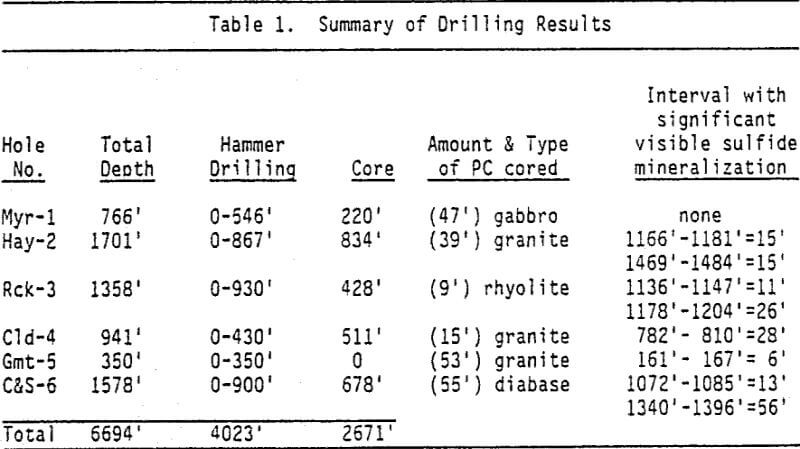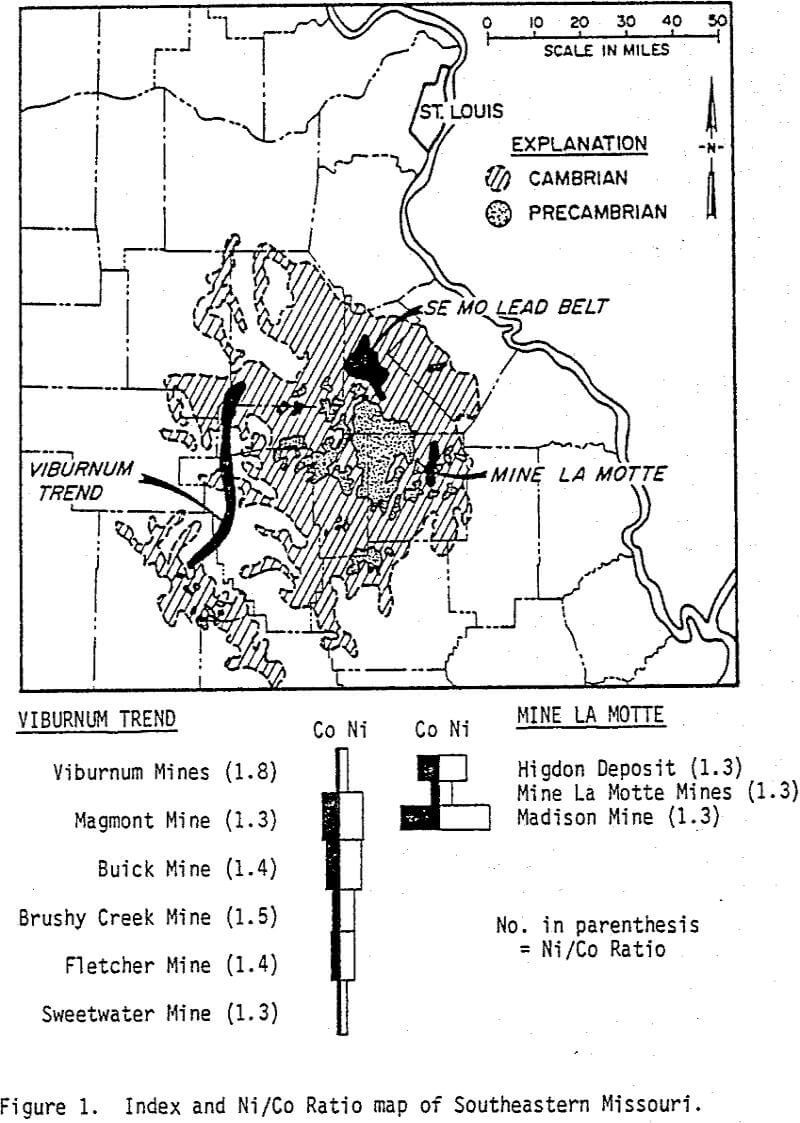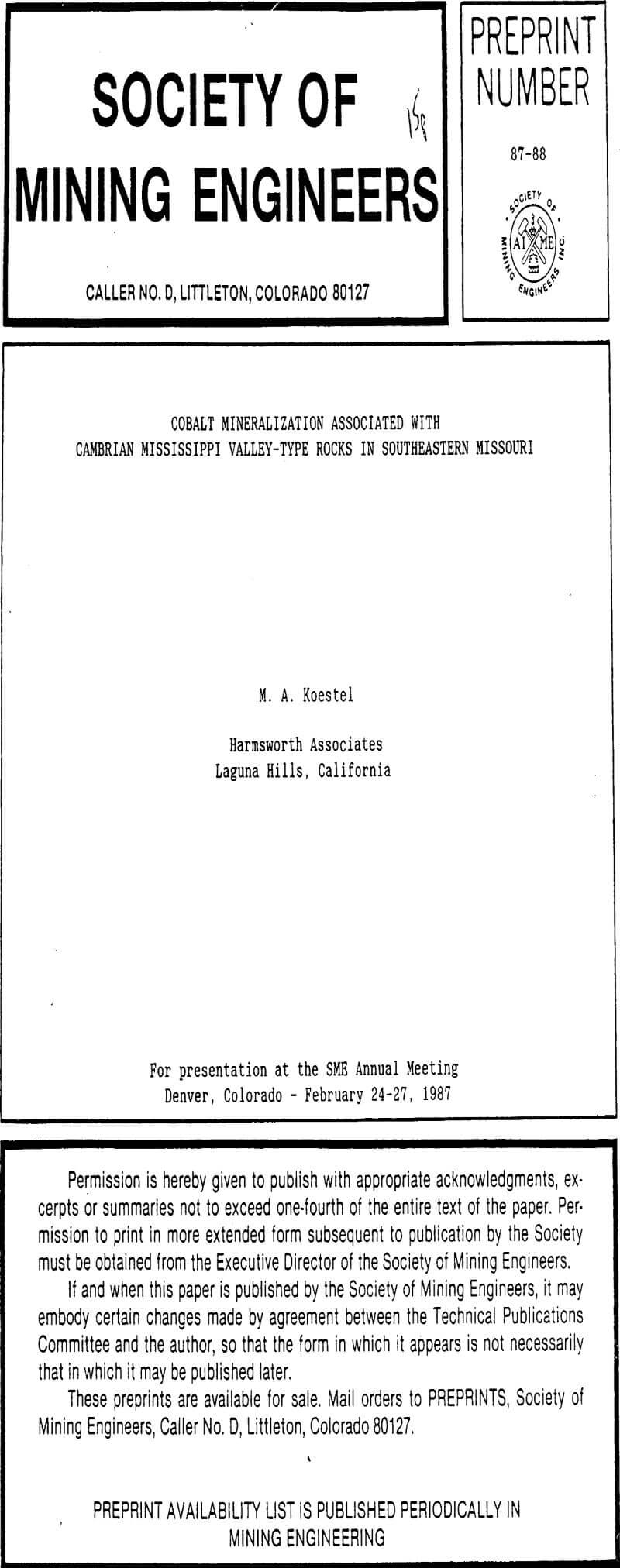Cobalt-sulfide mineralization can be found in potentially economic quantities where permeable, basal Cambrian formations “pinchout” against Precambrian paleotopographic highs. These environments are common around the Saint Francois Mountains of southeastern Missouri and they share many similarities with the geologic environments of Zambia and Zaire in South Africa.
Exploration Philosophy
Exploring for cobalt-bearing minerals in southern Missouri’s lead-zinc district, Molycorp made comparisons to the geologically similar environments of Zambia and Zaire, South Africa. Under the assumption that the lead-zinc mineralization of southern Missouri was derived basinally, it was felt that the copper-nickel-cobalt mineralization found there originates from a more local, mafic source.
In designing the exploration program and choosing drill targets, all available subsurface data presently available from outside and internal sources was collected and plotted both in plan view and as fence diagrams. From these fence diagrams, previously unknown buried Precambrian topographic highs were discovered as were the associated pinchout of the lower Cambrian Lamotte sandstone and Bonneterre dolomite against these highs.
The experience gained from our drilling program enhanced our chances of making a major discovery in rough proportion to the number of holes that were drilled.
Geology
The St. Francois Mountains in southeastern Missouri were Precambrian paleotopographic highs, or “knobs,” against which shallow water marine carbonates of lower Cambrian age were deposited and hence pinchout against. This environment covers in excess of 10,000 square miles with an untold number of Precambrian knobs still buried beneath the sedimentary cover. The possibilities, therefore, of discovering a yet unfound ore body seems rather high.
In general, the eastern and southern margins of the St. Francois Mountains, where Molycorp drilled during 1982, are characterized by upper Cambrian and lower Ordovician shallow water marine carbonate rocks belonging to the Roubidoux, Gasconade, Eminence and Potosi Formations.
The limestone-dolomite interface appears to be an important ore-localizing factor in the strataform deposits of southeastern Missouri. Ore is usually found at or near this boundary, most frequently in the Bonneterre dolomite. The limestone is commonly nearby, either to the side, above, below or as an island surrounded by the ore body.
Though it appears that the bulk of the Pb-Zn mineralization found in this district was deposited during one long stage at temperatures ranging from 70°C to 150°C, other minor periods of mineralization and/or changes in metal content with time are noted.
Drilling Results
In an effort to further define local stratigraphy and eventually locate an ore body, six relatively deep holes were drilled in the summer and fall of 1982. Following the convention of hammer drilling all holes to the bottom of the Potosi Formation so as to reach rock amenable to coring, and then core drilling to the Precambrian basement from there, two of these six holes encountered significant sulfide mineralization in pinchout-type environments.
The primary stages involved in the drilling of the six holes consisted of triconing through surficial, unconsolidated material and setting six or eight-inch sleeve, whichever was required. Hammer drilling was performed once competent rock was encountered and random sampling of the rock chips was made at ten-foot intervals.
Hammer drilling was terminated at depths approximating the bottom of the Potosi Formation and finished by setting four-inch casing to the bottom of the hole. Diamond core drilling began once the hammer drill moved off the drillsite. Core drilling was done from the Upper Derby-Doerun Dolomite, through the Davis shale,
The average depth of the six holes drilled was 1115.7 feet, the range being 350 to 1701 feet with a total footage of 6694 feet.
The two holes with the best sulfide intercepts, Cld-4 and C&S-6, were hosting the sulfides in the lower and upper Bonneterre dolomite respectively. Drill hole Cld-4 possessed many features considered by geologists in the Viburnam Trend to be favorable to Mississippi Valley-type ore deposits in the mid-continent region.

Sulfide mineralization in the shaley portions of the core usually occurred as very fine-grained disseminations and as lenses or pods, perhaps following relict bedding or depositional features. It seems likely that these concentrations exist primarily due to the low permeability of the shales and due to the reducing or organic-chemical properties which aided the precipitation of the sulfides.


